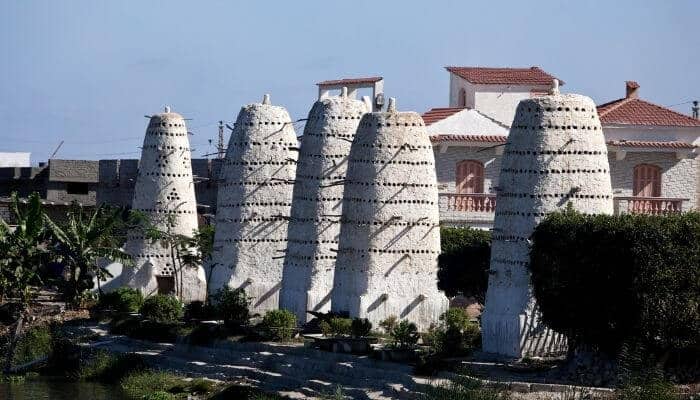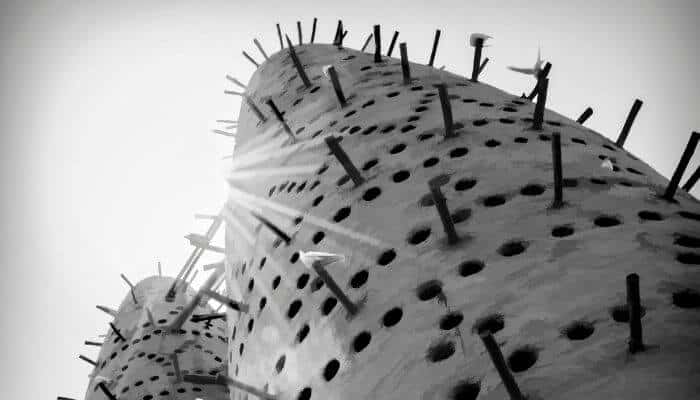Pigeon towers are what we typically call dovecotes. They are called towers because of their height and round shape (mostly).
Although rare nowadays, there are some that have stood the test of time.
They can be found mostly in Egypt and Iran but also all over the Middle East.
Rise of the Towers
Mankind’s relationship with pigeons started far back in the mists of time.
Archaeologist historians have long said that 8500 years ago, Neolithic man domesticated the rock dove (from which all pigeons are descended). Some say it dates back more than 10,000 years.

When man learned to cultivate crops and became permanent settlers, pigeons drew near their villages. Always opportunists, the pigeons came for seeds, grain, and discarded foodstuffs.
Man saw them as a readily available food source.
To hold them captive to rear them, they built structures to house them.
The greatest concentration of towers that are still standing and some that are still in use are mainly in the Middle East. As civilization spread ever outwards, so did the raising of pigeons.
An Egyptian Tradition
It was a natural progression that the greatest civilization at the time, the Ancient Egyptians embraced the relationship.
The raising of pigeons is recorded in hieroglyphs and in the tombs of the Pharaohs.
Egyptians raised the birds for the table – pigeon meat is still considered a delicacy where they are traditionally served roasted and stuffed with fragrant rice.
They used pigeon poop as guano (fertilizer) and they found other countless uses for the birds.
Holding a significant number of birds captive requires a home for them. These days we keep domesticated pigeons in cages, lofts, or dovecotes.
The Egyptians constructed towers as dedicated pigeon homes.
The birds were attracted to the towers because they resembled the rocky ledges and crevices in which the birds like to roost, nest, mate, and rear their young in the wild.
Architecture of the Towers
Although there were strays from the norm if individual builders wanted to add their own or their master’s touches, but the basic structure consisted of a rounded outer drum or wall with a height of up to three meters topped with a roof.
Wooden beams would brace the tower which was constructed of mud bricks.
Another tower was built within the outer structure which was about a third of the height. This inner structure contained the nesting niches for the pigeons.

The birds enter and exit the tower through openings in the outer wall which are ideal for the pigeons’ size but too small for birds of prey and other predators to get in.
This was the basic design, but variations on the theme can be found.
Sometimes they consist of only an outer wall with the pigeon niches molded into the inner curve of the drum.
Some of the towers have perching boxes, holes or ledges inside them, where the birds can lay their eggs.

Also made of mud, they can easily be removed and replaced.
Pigeon towers are a feature of the skyline. Many of them are cone-shaped.
From a broad base, they taper upwards and come to an enclosed rounded top.
Although they serve a utilitarian function, people have embellished them in different ways. Through design, the builders have added beauty to these structures.
Some have been left with the original colors of the building materials such a mud-brick, others have been painted. The outside surfaces may be smooth or stuccoed.
Another feature of the towers are the entrances. They come in square, round or arched openings. A ledge or sill may jut out from the bottom to act as perches.

Also, the setting and configuration of the entrances come in different design patterns. In some, the entrance and exit holes can be found near the very top of the towers, in other cases, they sit at different levels.
Still others are set in clusters to make a repeated design. Another feature may be poles sticking out under or near the holes to be used as perches, the same as the ledges.
In Siwa, for example, you will see high whitewashed towers with elaborate patterns of holes and spikes sticking out of the structures.
At Mit Ghmir in the Nile Delta, it looks like a mini New York with dozens of adobe towers piercing the skyline.
They have been noticed by the tourist industry and have become a quirky point of interest.
Ancient Ways
Pigeon towers have been built this way in Egypt in memoriam.
Despite new kinds of building materials and methods of construction, they stay the same.
This is because they are so easy to build. The materials are natural, easily sourced, and cheap.
All it takes is a bit of effort. Why try to change something that already works fine?
Each pigeon fancier that passes down their passion to the next generation also pass on their particular design pattern. In this way, Egyptian pigeon towers have become part of the country’s architectural culture.
Towers are not the only way Egyptians provided and still provide homes for pigeons.
If you look out over the poorer districts in Cairo you will see pigeon towers and lofts on top of the houses.
Global Reach
Egypt isn’t the only place to find these towers.
They are spread over many countries of the Middle East and far beyond.
Pigeon keeping has traveled as far as the Americas and China.
Many of the later structures that we call dovecotes still conform to the basic design and in some cases have become aesthetically pleasing buildings.
The country that most rivals Egypt in both number of towers and the robustness of design of pigeon towers is Iran.
Iranian Pigeon Towers
It was in the 16th and 17th centuries that pigeons had their heyday in Iran.
Not only were the birds kept for meat but primarily they were raised for their guano to be used as fertilizer for the highly-prized melon and cucumber fields.
Mainly in the Isfahan region, Iranian pigeon towers are six to eight storeys high (18 meters) and up to 22 meters (75 feet) in diameter.

They follow the basic Egyptian design – the tower filled with a honeycomb of roosts – but are limited to eight traditional forms.
Builders add their own unique architectural touches and flourishes.
Like the pigeon towers of Egypt, they are built of mud brick, but many are overlaid with plaster and lime with some examples being touted as the most beautiful dovecotes in the world.
Each tower can hold up to 14,000 birds.
Where once there were thousands of towers, very few remain operational, and many are falling into ruin since the world switched to artificial fertilizer.
Around 300 towers remain in Isfahan and luckily for human/pigeon history, 65 of them are protected by being on the Iranian National Heritage List.
